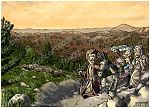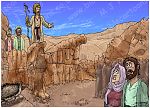Bible Cartoon: Matthew 02 - The Nativity SET 02 - Scene 15- Jesus taken to Nazareth in Galilee
Click on Add to cart button below shopping cart.
Purchased Bible Cartoons do not have watermarks. Links to Cartoons provided on email once purchase is completed.Bible Book: Matthew
Bible Book Code: 4000202202
Scene no: 15 of 15
Bible Reference & Cartoon Description
Matthew 2:22-23 (NLT)
22 But when he [Joseph] learned that the new ruler of Judea was Herod’s son Archelaus, he was afraid to go there. Then, after being warned in a dream, he left for the region of Galilee. 23 So the family went and lived in a town called Nazareth. This fulfilled what the prophets had said: “He will be called a Nazarene.”
DRAWING NOTES:
TIME OF DAY:
Afternoon.
LIGHTING NOTES:
The sun is quite high in the sky on the right (west), casting shadows to the left & below figures & objects.
CHARACTERS PRESENT:
Joseph leading a donkey, with Mary riding & holding on to the toddler Jesus.
RESEARCH/ADDITIONAL NOTES:
This is the last scene in the second set of Bible Cartoons telling the story of the Nativity; the birth of Jesus the Christ. We know from the verses above that Joseph was afraid to take Mary & Jesus back to Bethlehem (his home town) & instead elected to travel about 100 miles further north, to the more remote location of Nazareth, near the Sea of Galilee.
There are two versions of the background of this scene, the first has the birds & foreground plants, the second omits these details.
Here’s the scene without the figures, but including the birds & foreground plants.

Background of Matthew 02 – The Nativity SET 01 – Scene 15 – Jesus taken to Nazareth in Galilee (Version 01)
Click on the colour bar below to view/buy this Background:
Background of Matthew 02 – The Nativity SET 02 – Scene 15 – Jesus taken to Nazareth in Galilee (Version 01)
Here’s the scene without the figures, birds or foreground plants.

Background of Matthew 02 – The Nativity SET 01 – Scene 15 – Jesus taken to Nazareth in Galilee (Version 02)
Click on the colour bar below to view/buy this Background:
Background of Matthew 02 – The Nativity SET 02 – Scene 15 – Jesus taken to Nazareth in Galilee (Version 02)
The two birds flying in the sky are Ardea purpurea (aka Purple Heron), of the Pelecaniformes Order – Ardéidae Family. It has purple-brown plumage with slate-grey wings, reddish-brown breast, black belly and reddish-purple flanks and scapulars. It’s crown and long feathers’ crest are black. Rear neck is pale reddish-brown. The rest of the neck is white with black streaks, extending on upper breast. A black line is running down the neck sides. The long pointed bill is yellow and longer than in other herons. Eyes are pale yellow. Legs and feet are orange yellow. Purple Heron has longer toes than other species, allowing walking on floating vegetation and dense bushes. Very conspicuous in flight, these long toes make it easier to identify the species.
Length of 2.5 – 2.9 feet (78 – 90 cm), with a wingspan of 3.9 – 4.9 feet (120 – 150cm) & a weight of 1.1 – 2.9 lbs (525 – 1,345 grams).
Purple Heron breeds in marshes and lakes with extensive reedbeds. Outside breeding season, they prefer more open wetlands with fringing vegetation.
Geographical variations are moderate, and breeding birds seem to be established in some parts of their range.
Purple Heron breeds from tropics to mid-temperate countries. We can find them throughout Europe, Southern Asia and Africa. European birds winter in tropical Africa.
Purple Heron feeds in shallow water, waiting motionless for prey, stalking slowly fishes and frogs, or spearing them with its long pointed powerful bill. They feed in freshwater wetlands. Purple Heron feeds on fishes, frogs, invertebrates, reptiles, small rodents and small birds.
Purple Heron remain in reedbeds more than Grey Heron. It is a shy and solitary hunter, mostly at night to the early morning. It waits for prey under the cover, rarely wading in deep water, and sometimes, it perches on low trees and bushes above water, searching for food.
They roost mostly in coastal areas, such as mangroves and estuaries.
Purple Heron flies slowly with retracted neck, and longs legs and toes projected behind. Its flight is powerful and regular, with slow wing beats.
[Source: https://www.oiseaux-birds.com/card-purple-heron.html]





